Geoblog.pl  bzmot
bzmot  Podróże
Podróże  Łosie okrakiem przez Amerykę - V2.0 - The Moose Do America Again - Click Here!!!
Łosie okrakiem przez Amerykę - V2.0 - The Moose Do America Again - Click Here!!!  Pozegnanie z Sipolandia / Bye bye Sipoland
Pozegnanie z Sipolandia / Bye bye Sipoland
 bzmot
bzmot  Podróże
Podróże  Łosie okrakiem przez Amerykę - V2.0 - The Moose Do America Again - Click Here!!!
Łosie okrakiem przez Amerykę - V2.0 - The Moose Do America Again - Click Here!!!  Pozegnanie z Sipolandia / Bye bye Sipoland
Pozegnanie z Sipolandia / Bye bye Sipoland 
Tytulem komentarza do tytulu: dlaczego "sípo"landia? Otoz po czym rozpoznaje sie Chilijczyka, jesli nie zna sie jeszcze amerykanskich akcentow? Po po. A konkretnie, po malej partykule wtracanej zupelnie bez powodu przez mieszkancow Chile po slowach takich jak "sí" (tak), "bueno" (dobrze) czy "ya" (jasne, aha, ok). No i jak co chwile na ulicy slyszy sie "sí, po", "ya, po", to potem taki tytul sam przychodzi do glowy... A skad to "po"? To chilijski nieformalny skrot od slowa "pues" (wiec, no).
A oto wpis wlasciwy:
Puerto Montt to ostatnie miasto, do którego można się dostać regularnym transportem przez Chile. Potem zaczyna się carretera austral czyli żwirowa droga do Coyhaique (bagatela 1000km), ponoć widowiskowa, ale nieobsługiwana przez żadną firmę. Ruch tam prawie żaden, więc szanse na stopa marne, pozostaje stracić fortunę na wynajem jeepa, ewentualnie rower dla twardzieli. Dalej na południe (np. do Punta Arenas) jedzie się przez Argentynę, a do Puerto Natales już chyba tylko drogą powietrzną (a od cen można osiwieć) lub promem (j.w.).
Taki prom firmy Navimag (3,5 dnia, po sezonie za 300 dolarów od osoby) chcieliśmy już nawet wykupić, bo strasznie rozreklamowany jako jedna z największych atrakcji Chile, że fiordy i nie wiem jakie fajerwerki, ale zdjęć oszałamiających nie udało nam się znaleźć na potwierdzenie. W dodatku jest duża szansa na deszcz. Chyba wolimy podobną kasę w Norwegii wybulić. Ale samo Puerto Montt też nam znajomi zachwalali, więc niech będzie. Dojeżdżamy przed dziesiątą i dajemy się zhaltować jakiejś kobicie, która nieco spuszcza nam z ceny (60 zł za dwójkę z łazienką, zamiast 72 za dwójkę bez). Oszczędności nie rekompensowała jakość, bo było zimno jak w psiarni (nie było grzejnika na wyposażeniu), „prywatna” łazienka stała na korytarzu, śniadania brak a baba i jej mamuśka były niezbyt przyjemne. Następnego dnia zmądrzeliśmy i przenieśliśmy się do przeuroczej pani, 2 ulice obok. Byliśmy jedynymi gośćmi, dom ładniutki, dobrze ogrzany (chociaż miejscowy standard jest taki, że piecyk jest jeden na korytarzu i stamtąd ciepło się rozchodzi po pokojach), a pani Eliana piekła nam na śniadanie domowy chleb i szarlotkę. Dom nie ma szyldu, ale w sprawie noclegu można się kontaktować mailem na adres hospedajevistaalmar@yahoo.es. Powołajcie się na parę Polaków, którzy ją serdecznie wspominają. Uczcie się na naszych błędach i nie dajcie się znęcić señorze Victorii. Podobno jak się zjawia na dworcu, to przegania wszystkich innych gospodarzy, a jak turysta na miejscu się rozmyśli, bo rzeczywistość rozmija się z obietnicami, to zażywna staruszka obrzuca go stekiem wyzwisk. Miasteczko ma bardzo ciekawą architekturę, drewniane domki z zewnątrz obkładane charakterystycznymi dla regionu płytkami o wymyślnych kształtach. A kolory wszelakie i raczej zdecydowane. Niestety mało słońca było, więc dużo przykładów wam nie pokażemy. Centrum jest dość nieciekawe, ładniej i spokojniej jest tam, gdzie mieszkaliśmy, w okolicy ul. Goecke. Całkiem sensownie można zjeść w O.K. Corral, ale rozbawiło mnie chilijskie zamieszanie terminologiczne. To co w Argentynie zwie się bife de lomo (czyli zacny gruby stek) tu nazywa się po prostu lomo, natomiast bife to cienki stek jak polskie bitki. Radzę ten cieńszy wziąć, bo grubszy nieco twardy. Natomiast absolutnym rozczarowaniem skończyła się wizyta w ciastkarni niemieckiej. O rodowodzie właścicieli świadczy wielkie na całą ścianę zdjęcie założyciela w mundurze Wehrmachtu oraz jego małżonki. Fetyszyści. No, rozumiem to trochę. Widziałam już kiedyś mundurowe zdjęcia dziadków w domach niemieckich znajomych. Chodzi o to, żeby wyraźnie pokazać, że dziadka na front powołali, a nie się do SS zgłosił. A na południu Chile, jak głosi plotka, sporo się SS-manów schroniło, więc jak ktoś się może mniej haniebnym mundurem poszczycić, to chętnie to robi. Co nie zmienia faktu, że ciasta były ohydne. Łoś się z miejsca przesłodził, a mój placek śliwkowy zamiast śliwek miał lokalne owoce o nazwie murta – o smaku poziomki tylko dużo mniej intensywnym plus goździków, a o wyglądzie borówki. Surowe smakuje to interesująco, ale po upieczeniu jest strasznie ze smaku wypłukane. Lokalne psiaki były zadowolone. Tak samo lokalne żule, kiedy znalazły nasze niedopite piwo miodowe (a fuj). Kosztowało to słono (za tego paskudnego Kuntzmana 0,3 l policzyli 9 zł) a i tak nie zdarli z nas więcej dzięki mojej czujności. Okazało się, że przy składaniu zamówienia podali nam ceny na wynos, a jak usiedliśmy przy stoliku, to w menu były wyższe. Przytomnie spytałam, czy jest różnica. Same się panienki na szaro zrobiły, bo ciasta już były na talerzykach, więc musiały je przełożyć do pudełka. Trzeba było już pozwolić nam spokojnie na miejscu zjeść, nie miałyby dodatkowej roboty, a miejsca nikomu nie zabieraliśmy, bo było puściutko.
Niedaleko Puerto Montt leży wysepka Chiloe, na którą chilijscy znajomi z wielkim entuzjazmem nas wysyłali, zaraz potem dodając, że zawsze tam pada, ale mimo to jest ślicznie. Dla mnie jest to jakaś sprzeczność nie do pogodzenia, ale na szczęście rozpogodziło się i zaryzykowaliśmy wypad na wyspę. Rano w P.M niebo było niebieściutkie, z autobusu też wyglądało obiecująco, ale ponad trzy godziny drogi (w tym przeprawa promowa) wystarczyły, żeby akurat dojechać na chmury. Wysiedliśmy w głównym miasteczku, Castro i szukamy głównego placu z wielką drewnianą katedrą w kolorze niebiesko-pomarańczowym. Hm, nie ma ani jednego, ani drugiego. Okazało się, że plaza de armas to ten wielki odgrodzony plac budowy, a katedra o wyżej wspomnianych kolorach jest żółtawa, bo farba na drewnianych klepkach szybko wietrzeje i od czasu gdy zawitał tu autor naszego przewodnika już zdążyli kościół przemalować, a nowy kolor też już się zestarzał. Chociaż kościół jest bardzo wysoki i przestronny, bardzo przytulnie w środku wygląda, bo też cały jest drewnem wykładany. Ponieważ drewno kiepsko izoluje przez strasznym wiatrem, wzdłuż naw stoją liczne grzejniki, żeby wierni nie dygotali podczas nabożeństwa. I nikt się nie przejmuje, że to „niekomfo”. Zaraz potem wpadła mi w oko knajpka z curanto. Wiedziałam, że jest to danie wczesnopopołudniowe, więc od razu tam zaszliśmy. Curanto z Bariloche już opisywaliśmy, ale obiecałam, że dam szansę chilijskiemu - słowo się rzekło. Zresztą wyspa z niego słynie, więc jak już próbować, to u źródła. Na wielkim półmisku podają siatkę z nici, wypełnioną wszelkimi dobrami. Nie ma marchewki ani kukurydzy w całości, za to są ziemniaki, kurczak, małże, pikantna kiełbaska, wędzonka a na wierzchu coś jakby knedelek ze skwarkami. Wszystko to dusiło się razem we wspólnym sosie w wielkim garnku, więc smaki się pięknie wymieszały. A małży tak świeżych nie widziałam jak żyję. A policzyli mi za to, jak za kanapkę z mięsem w Chile kontynentalnym (15 zł). Na stoliku obok jedną porcją dwóch panów się najadło, naprawdę jest ogromna. Zapraszam do El Buen Amigo pod adres Gamboa 489.
Drewniane kościółki są głównym magnesem wyspy, bo kilka z nich znajduje się na liście UNESCO. Warto na wysepce zostać kilka dni i rowerkiem albo skuterem się przemieszczać między nimi, są kempingi i tanie kwatery. Ale w jeden dzień niedużo można zobaczyć, bo odległości między miasteczkami to jednak nie rzut beretem, a jeszcze trzeba na autobus powrotny wrócić. My pojechaliśmy tylko do Achao, do kościółka w barwach ukraińskich. Niestety był zamknięty po włamaniu. Inna atrakcja to kolorowe portowe domki na palach, zwane palafitos. W sezonie można się przepłynąć motorówką po porcie, bo fasady widać tylko z wody. Nam pozostało oglądanie ich od tyłu. Niesamowite, że to się nie zawala, bo spadzistość jest znaczna, a palowa konstrukcja wygląda jak chybotliwe rusztowanie. W drodze do Achao okazało się, że jest też inne osiedle palafitos, które widać z mostu, więc jednak nas nie ominęły.
Następnego dnia na kontynencie znowu wyszło słońce, więc wybraliśmy się do pobliskiego miasteczka Frutillar, z widokiem (kiedy nie ma chmur) na wulkan Osorno. Po drodze okazało się, że jeszcze lepszy widok (patrz nawias powyżej) jest w Puerto Varaz, bo tam widać dwa wulkany jednocześnie. Obydwa miasteczka (i Chiloe również) mają domki tego samego typu, co w Puerto Montt, bardzo kolorowe i klimatyczne.
Puerto Montt is the last town you can reach by regular transport through Chile. Then the carretera austral starts, or a gravel road to Coyhaique (nothing short of 1000km), supposedly a spectacular one but with no bus service. There’s almost no traffic, so don’t count on hitchhiking. The only choice you have is splurging on a jeep rental or taking a bike, for the hardcore explorers. Further south (e.g. to Punta Arenas) you get through Argentina, and to Puerto Natales you go mostly by air (with prices giving you a headache) or by ferry (likewise).
We were planning to board this Navimag ferry (3.5 day, for 300 bucks per person in low season) as it is highly publicized as one of Chile’s greatest attractions, with fiords and what not, but we couldn’t find any photos to support that claim. In addition, the risk of rain is quite high. I guess we prefer to spend similar money in Norway to see the real deal. But friends recommended seeing the town of Puerto Montt as well so let it be. We get there at 10 p.m. and get lured by a woman who offers us a slightly lower price (20 USD for a double with a bathroom instead of 24 for a double without one). The saving wasn’t worth it – it was cold as in a morgue (no heater in the room), the “private” bathroom was a shared one down the hall, no breakfast and the old hag and her mummy were far from nice. The next day we got smarter and moved two blocks away to a charming lady’s house. We were the only guests, the house was neat and well heated (although the local standard is to have one central heater in the hall from which the heat spreads to the rooms), and Eliana would bake us home-made bread and apple pie for breakfast. The house has no signboard but you can ask for accommodation at hospedajevistaalmar@yahoo.es. Say you have been tipped about her by a couple of Poles who have a tender memory of her. Learn from our mistakes and avoid señora Victoria. Apparently when she shows up at the bus station, she chases away all the other landlords and if a tourist gets to her place and doesn’t want to stay cuz the reality is far from what was promised, the agile old lady will tell him in no uncertain terms what she thinks he is. The town has a very interesting architecture, with wooden houses with outside walls covered with region specific wooden slates of fancy shapes. And of all the possible colors, usually bright ones. Sadly there was little sun so we have few examples to show you. The center is nothing interesting, the area around Goecke street where we lived is a prettier and more quiet neighborhood. You can get a decent meal in O.K. Corral, but I was quite amused by the Chilean confusion of terms. What is called bife de lomo in Argentina (that is a neat thick steak) here is called just lomo, while bife is a really thin steak. I recommend the thinner one as the thick one tends to be hard to chew. A visit to a German pastry shop, however, was a total bummer. The German heritage of the owner is attested by a wall-size photo of the founder wearing a Wehrmacht uniform and his wife. Fricking fetichists. Well, actually I get it. I’ve seen uniform pictures of grandpas at German friends’ houses. The idea is to show specifically that the grandpa was drafted to fight on the front line rather than volunteered to serve with SS. And in southern Chile, as the rumor has it, a lot of SS-men found refuge after the war so if somebody can boast a less embarrassing uniform in the family, he will. Which doesn’t change the fact that the pastries were awful. Moose felt sick and my plum pie rather than have plums in it contained some local fruit called murta, with a taste of a wild strawberry and cloves. When raw, it tastes interesting but baked is really insipid. The local puppies were happy. So were the local bums when they found our half-drunk honey beer (yuck). We paid through the nose (they charged us 3 USD for this lousy 0,3l Kuntzman) and we were still lucky they didn’t rip us off even more. It turned out that when we placed the order they gave us „to go” prices and when we sat at a table, prices on the menu were higher. I asked if there was a difference in prices. The girls got hoisted with their own petard cuz the pie was already served on plates and they had to move it to a box. They should have let us eat inside and they would save themselves the extra work.
Near Puerto Montt there lies the island of Chiloe, of which all of our Chilean friends were telling us with much enthusiasm, adding that it always rains there but it’s still gorgeous. For me it’s a unreconciable contradiction but luckily the sky cleared up and we ventured a trip to the island. In the early morning, the sky in P.M was perfectly blue, and it still looked promising from the bus window, but the three hours ride (including the ferry) were enough to arrive just in time to see clouds. We get off in the main town, Castro and look for the main square with a giant blue and orange wooden cathedral. Well, we see none of them. It turns out plaza de armas is the huge enclosed construction site and the cathedral having the above mentioned colors is now yellowish as paint peels off quickly from wooden slates and since the author of our guidebook was in town, the church has been repainted and the new color has already started fading already. Though the building is very tall and spacious, it looks very cozy inside as it’s all finished in wood as well. Since wood provides poor insulation from the terrible wind, there are lots of heaters lining the aisle so that the public doesn’t shiver with cold during the service. And nobody thinks it unseemly. Next, I eyed a curanto place. I knew it’s a lunch meal so we went in right away. I already described the curanto from Bariloche, but I promised to give a chance to the Chilean one so here we are. Anyway, the island is famous for its curanto so why not try it at the very source. They serve a big plate with a thread net containing all kinds of goodies. No sign of carrots or corn in whole, and instead there’s potatoes, chicken, clams , a spicy sausage, bacon and a sort of a dumpling with cracklings. All this stewed together in a big pan so the flavors have nicely blended. And I have never had such fresh clams. They charged us the equivalent of a meat sandwich in the continental Chile (5 USD). At another table, one portion filled two guys so it is quite big. Don’t hesitate to drop by the El Buen Amigo at Gamboa 489.
The wooden churches are the island’s chief magnet as several of these are UNESCO listed. It’s worth staying on the island for several days and move between them on a bike or a scooter. There are campgrounds and cheap rooms to rent. But in just one day it’s hard to see a lot as distances between towns aren’t a joke and you need to catch the return bus. We only went as far as Achao, to a church in Swedish colors. Unfortunately, it was closed due to a burglary. Another attraction is the colorful stilted port houses called palafitos. In the high season you can take a motorboat ride as the facades can only be seen from the water. We could only see their back side. It’s unbelievable that they are not coming down as the pale structure looks like a shaky scaffolding. On our way to Achao we found out that there is another palafitos neighborhood that can be seen from the bridge, so we didn’t miss out on anything after all.
The next day on the continent, the sun was out again so we went to the nearby town of Frutillar, with a panorama (when there are no clouds) of the Osorno volcano. On our way there, we realized that Puerto Varaz offers yet better view (ditto) as you can see two volcanoes at once there. Both towns (and Chiloe as well) have houses of the same type as in Puerto Montt, very colorful and cute.
A oto wpis wlasciwy:
Puerto Montt to ostatnie miasto, do którego można się dostać regularnym transportem przez Chile. Potem zaczyna się carretera austral czyli żwirowa droga do Coyhaique (bagatela 1000km), ponoć widowiskowa, ale nieobsługiwana przez żadną firmę. Ruch tam prawie żaden, więc szanse na stopa marne, pozostaje stracić fortunę na wynajem jeepa, ewentualnie rower dla twardzieli. Dalej na południe (np. do Punta Arenas) jedzie się przez Argentynę, a do Puerto Natales już chyba tylko drogą powietrzną (a od cen można osiwieć) lub promem (j.w.).
Taki prom firmy Navimag (3,5 dnia, po sezonie za 300 dolarów od osoby) chcieliśmy już nawet wykupić, bo strasznie rozreklamowany jako jedna z największych atrakcji Chile, że fiordy i nie wiem jakie fajerwerki, ale zdjęć oszałamiających nie udało nam się znaleźć na potwierdzenie. W dodatku jest duża szansa na deszcz. Chyba wolimy podobną kasę w Norwegii wybulić. Ale samo Puerto Montt też nam znajomi zachwalali, więc niech będzie. Dojeżdżamy przed dziesiątą i dajemy się zhaltować jakiejś kobicie, która nieco spuszcza nam z ceny (60 zł za dwójkę z łazienką, zamiast 72 za dwójkę bez). Oszczędności nie rekompensowała jakość, bo było zimno jak w psiarni (nie było grzejnika na wyposażeniu), „prywatna” łazienka stała na korytarzu, śniadania brak a baba i jej mamuśka były niezbyt przyjemne. Następnego dnia zmądrzeliśmy i przenieśliśmy się do przeuroczej pani, 2 ulice obok. Byliśmy jedynymi gośćmi, dom ładniutki, dobrze ogrzany (chociaż miejscowy standard jest taki, że piecyk jest jeden na korytarzu i stamtąd ciepło się rozchodzi po pokojach), a pani Eliana piekła nam na śniadanie domowy chleb i szarlotkę. Dom nie ma szyldu, ale w sprawie noclegu można się kontaktować mailem na adres hospedajevistaalmar@yahoo.es. Powołajcie się na parę Polaków, którzy ją serdecznie wspominają. Uczcie się na naszych błędach i nie dajcie się znęcić señorze Victorii. Podobno jak się zjawia na dworcu, to przegania wszystkich innych gospodarzy, a jak turysta na miejscu się rozmyśli, bo rzeczywistość rozmija się z obietnicami, to zażywna staruszka obrzuca go stekiem wyzwisk. Miasteczko ma bardzo ciekawą architekturę, drewniane domki z zewnątrz obkładane charakterystycznymi dla regionu płytkami o wymyślnych kształtach. A kolory wszelakie i raczej zdecydowane. Niestety mało słońca było, więc dużo przykładów wam nie pokażemy. Centrum jest dość nieciekawe, ładniej i spokojniej jest tam, gdzie mieszkaliśmy, w okolicy ul. Goecke. Całkiem sensownie można zjeść w O.K. Corral, ale rozbawiło mnie chilijskie zamieszanie terminologiczne. To co w Argentynie zwie się bife de lomo (czyli zacny gruby stek) tu nazywa się po prostu lomo, natomiast bife to cienki stek jak polskie bitki. Radzę ten cieńszy wziąć, bo grubszy nieco twardy. Natomiast absolutnym rozczarowaniem skończyła się wizyta w ciastkarni niemieckiej. O rodowodzie właścicieli świadczy wielkie na całą ścianę zdjęcie założyciela w mundurze Wehrmachtu oraz jego małżonki. Fetyszyści. No, rozumiem to trochę. Widziałam już kiedyś mundurowe zdjęcia dziadków w domach niemieckich znajomych. Chodzi o to, żeby wyraźnie pokazać, że dziadka na front powołali, a nie się do SS zgłosił. A na południu Chile, jak głosi plotka, sporo się SS-manów schroniło, więc jak ktoś się może mniej haniebnym mundurem poszczycić, to chętnie to robi. Co nie zmienia faktu, że ciasta były ohydne. Łoś się z miejsca przesłodził, a mój placek śliwkowy zamiast śliwek miał lokalne owoce o nazwie murta – o smaku poziomki tylko dużo mniej intensywnym plus goździków, a o wyglądzie borówki. Surowe smakuje to interesująco, ale po upieczeniu jest strasznie ze smaku wypłukane. Lokalne psiaki były zadowolone. Tak samo lokalne żule, kiedy znalazły nasze niedopite piwo miodowe (a fuj). Kosztowało to słono (za tego paskudnego Kuntzmana 0,3 l policzyli 9 zł) a i tak nie zdarli z nas więcej dzięki mojej czujności. Okazało się, że przy składaniu zamówienia podali nam ceny na wynos, a jak usiedliśmy przy stoliku, to w menu były wyższe. Przytomnie spytałam, czy jest różnica. Same się panienki na szaro zrobiły, bo ciasta już były na talerzykach, więc musiały je przełożyć do pudełka. Trzeba było już pozwolić nam spokojnie na miejscu zjeść, nie miałyby dodatkowej roboty, a miejsca nikomu nie zabieraliśmy, bo było puściutko.
Niedaleko Puerto Montt leży wysepka Chiloe, na którą chilijscy znajomi z wielkim entuzjazmem nas wysyłali, zaraz potem dodając, że zawsze tam pada, ale mimo to jest ślicznie. Dla mnie jest to jakaś sprzeczność nie do pogodzenia, ale na szczęście rozpogodziło się i zaryzykowaliśmy wypad na wyspę. Rano w P.M niebo było niebieściutkie, z autobusu też wyglądało obiecująco, ale ponad trzy godziny drogi (w tym przeprawa promowa) wystarczyły, żeby akurat dojechać na chmury. Wysiedliśmy w głównym miasteczku, Castro i szukamy głównego placu z wielką drewnianą katedrą w kolorze niebiesko-pomarańczowym. Hm, nie ma ani jednego, ani drugiego. Okazało się, że plaza de armas to ten wielki odgrodzony plac budowy, a katedra o wyżej wspomnianych kolorach jest żółtawa, bo farba na drewnianych klepkach szybko wietrzeje i od czasu gdy zawitał tu autor naszego przewodnika już zdążyli kościół przemalować, a nowy kolor też już się zestarzał. Chociaż kościół jest bardzo wysoki i przestronny, bardzo przytulnie w środku wygląda, bo też cały jest drewnem wykładany. Ponieważ drewno kiepsko izoluje przez strasznym wiatrem, wzdłuż naw stoją liczne grzejniki, żeby wierni nie dygotali podczas nabożeństwa. I nikt się nie przejmuje, że to „niekomfo”. Zaraz potem wpadła mi w oko knajpka z curanto. Wiedziałam, że jest to danie wczesnopopołudniowe, więc od razu tam zaszliśmy. Curanto z Bariloche już opisywaliśmy, ale obiecałam, że dam szansę chilijskiemu - słowo się rzekło. Zresztą wyspa z niego słynie, więc jak już próbować, to u źródła. Na wielkim półmisku podają siatkę z nici, wypełnioną wszelkimi dobrami. Nie ma marchewki ani kukurydzy w całości, za to są ziemniaki, kurczak, małże, pikantna kiełbaska, wędzonka a na wierzchu coś jakby knedelek ze skwarkami. Wszystko to dusiło się razem we wspólnym sosie w wielkim garnku, więc smaki się pięknie wymieszały. A małży tak świeżych nie widziałam jak żyję. A policzyli mi za to, jak za kanapkę z mięsem w Chile kontynentalnym (15 zł). Na stoliku obok jedną porcją dwóch panów się najadło, naprawdę jest ogromna. Zapraszam do El Buen Amigo pod adres Gamboa 489.
Drewniane kościółki są głównym magnesem wyspy, bo kilka z nich znajduje się na liście UNESCO. Warto na wysepce zostać kilka dni i rowerkiem albo skuterem się przemieszczać między nimi, są kempingi i tanie kwatery. Ale w jeden dzień niedużo można zobaczyć, bo odległości między miasteczkami to jednak nie rzut beretem, a jeszcze trzeba na autobus powrotny wrócić. My pojechaliśmy tylko do Achao, do kościółka w barwach ukraińskich. Niestety był zamknięty po włamaniu. Inna atrakcja to kolorowe portowe domki na palach, zwane palafitos. W sezonie można się przepłynąć motorówką po porcie, bo fasady widać tylko z wody. Nam pozostało oglądanie ich od tyłu. Niesamowite, że to się nie zawala, bo spadzistość jest znaczna, a palowa konstrukcja wygląda jak chybotliwe rusztowanie. W drodze do Achao okazało się, że jest też inne osiedle palafitos, które widać z mostu, więc jednak nas nie ominęły.
Następnego dnia na kontynencie znowu wyszło słońce, więc wybraliśmy się do pobliskiego miasteczka Frutillar, z widokiem (kiedy nie ma chmur) na wulkan Osorno. Po drodze okazało się, że jeszcze lepszy widok (patrz nawias powyżej) jest w Puerto Varaz, bo tam widać dwa wulkany jednocześnie. Obydwa miasteczka (i Chiloe również) mają domki tego samego typu, co w Puerto Montt, bardzo kolorowe i klimatyczne.
Puerto Montt is the last town you can reach by regular transport through Chile. Then the carretera austral starts, or a gravel road to Coyhaique (nothing short of 1000km), supposedly a spectacular one but with no bus service. There’s almost no traffic, so don’t count on hitchhiking. The only choice you have is splurging on a jeep rental or taking a bike, for the hardcore explorers. Further south (e.g. to Punta Arenas) you get through Argentina, and to Puerto Natales you go mostly by air (with prices giving you a headache) or by ferry (likewise).
We were planning to board this Navimag ferry (3.5 day, for 300 bucks per person in low season) as it is highly publicized as one of Chile’s greatest attractions, with fiords and what not, but we couldn’t find any photos to support that claim. In addition, the risk of rain is quite high. I guess we prefer to spend similar money in Norway to see the real deal. But friends recommended seeing the town of Puerto Montt as well so let it be. We get there at 10 p.m. and get lured by a woman who offers us a slightly lower price (20 USD for a double with a bathroom instead of 24 for a double without one). The saving wasn’t worth it – it was cold as in a morgue (no heater in the room), the “private” bathroom was a shared one down the hall, no breakfast and the old hag and her mummy were far from nice. The next day we got smarter and moved two blocks away to a charming lady’s house. We were the only guests, the house was neat and well heated (although the local standard is to have one central heater in the hall from which the heat spreads to the rooms), and Eliana would bake us home-made bread and apple pie for breakfast. The house has no signboard but you can ask for accommodation at hospedajevistaalmar@yahoo.es. Say you have been tipped about her by a couple of Poles who have a tender memory of her. Learn from our mistakes and avoid señora Victoria. Apparently when she shows up at the bus station, she chases away all the other landlords and if a tourist gets to her place and doesn’t want to stay cuz the reality is far from what was promised, the agile old lady will tell him in no uncertain terms what she thinks he is. The town has a very interesting architecture, with wooden houses with outside walls covered with region specific wooden slates of fancy shapes. And of all the possible colors, usually bright ones. Sadly there was little sun so we have few examples to show you. The center is nothing interesting, the area around Goecke street where we lived is a prettier and more quiet neighborhood. You can get a decent meal in O.K. Corral, but I was quite amused by the Chilean confusion of terms. What is called bife de lomo in Argentina (that is a neat thick steak) here is called just lomo, while bife is a really thin steak. I recommend the thinner one as the thick one tends to be hard to chew. A visit to a German pastry shop, however, was a total bummer. The German heritage of the owner is attested by a wall-size photo of the founder wearing a Wehrmacht uniform and his wife. Fricking fetichists. Well, actually I get it. I’ve seen uniform pictures of grandpas at German friends’ houses. The idea is to show specifically that the grandpa was drafted to fight on the front line rather than volunteered to serve with SS. And in southern Chile, as the rumor has it, a lot of SS-men found refuge after the war so if somebody can boast a less embarrassing uniform in the family, he will. Which doesn’t change the fact that the pastries were awful. Moose felt sick and my plum pie rather than have plums in it contained some local fruit called murta, with a taste of a wild strawberry and cloves. When raw, it tastes interesting but baked is really insipid. The local puppies were happy. So were the local bums when they found our half-drunk honey beer (yuck). We paid through the nose (they charged us 3 USD for this lousy 0,3l Kuntzman) and we were still lucky they didn’t rip us off even more. It turned out that when we placed the order they gave us „to go” prices and when we sat at a table, prices on the menu were higher. I asked if there was a difference in prices. The girls got hoisted with their own petard cuz the pie was already served on plates and they had to move it to a box. They should have let us eat inside and they would save themselves the extra work.
Near Puerto Montt there lies the island of Chiloe, of which all of our Chilean friends were telling us with much enthusiasm, adding that it always rains there but it’s still gorgeous. For me it’s a unreconciable contradiction but luckily the sky cleared up and we ventured a trip to the island. In the early morning, the sky in P.M was perfectly blue, and it still looked promising from the bus window, but the three hours ride (including the ferry) were enough to arrive just in time to see clouds. We get off in the main town, Castro and look for the main square with a giant blue and orange wooden cathedral. Well, we see none of them. It turns out plaza de armas is the huge enclosed construction site and the cathedral having the above mentioned colors is now yellowish as paint peels off quickly from wooden slates and since the author of our guidebook was in town, the church has been repainted and the new color has already started fading already. Though the building is very tall and spacious, it looks very cozy inside as it’s all finished in wood as well. Since wood provides poor insulation from the terrible wind, there are lots of heaters lining the aisle so that the public doesn’t shiver with cold during the service. And nobody thinks it unseemly. Next, I eyed a curanto place. I knew it’s a lunch meal so we went in right away. I already described the curanto from Bariloche, but I promised to give a chance to the Chilean one so here we are. Anyway, the island is famous for its curanto so why not try it at the very source. They serve a big plate with a thread net containing all kinds of goodies. No sign of carrots or corn in whole, and instead there’s potatoes, chicken, clams , a spicy sausage, bacon and a sort of a dumpling with cracklings. All this stewed together in a big pan so the flavors have nicely blended. And I have never had such fresh clams. They charged us the equivalent of a meat sandwich in the continental Chile (5 USD). At another table, one portion filled two guys so it is quite big. Don’t hesitate to drop by the El Buen Amigo at Gamboa 489.
The wooden churches are the island’s chief magnet as several of these are UNESCO listed. It’s worth staying on the island for several days and move between them on a bike or a scooter. There are campgrounds and cheap rooms to rent. But in just one day it’s hard to see a lot as distances between towns aren’t a joke and you need to catch the return bus. We only went as far as Achao, to a church in Swedish colors. Unfortunately, it was closed due to a burglary. Another attraction is the colorful stilted port houses called palafitos. In the high season you can take a motorboat ride as the facades can only be seen from the water. We could only see their back side. It’s unbelievable that they are not coming down as the pale structure looks like a shaky scaffolding. On our way to Achao we found out that there is another palafitos neighborhood that can be seen from the bridge, so we didn’t miss out on anything after all.
The next day on the continent, the sun was out again so we went to the nearby town of Frutillar, with a panorama (when there are no clouds) of the Osorno volcano. On our way there, we realized that Puerto Varaz offers yet better view (ditto) as you can see two volcanoes at once there. Both towns (and Chiloe as well) have houses of the same type as in Puerto Montt, very colorful and cute.
Komentarze (0)






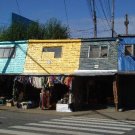
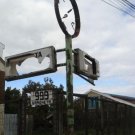
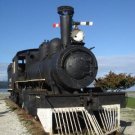
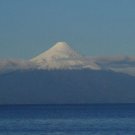
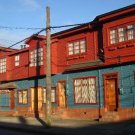
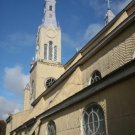
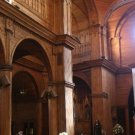
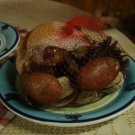
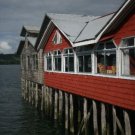
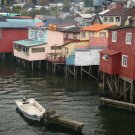

 Zasoby:
Zasoby: 






